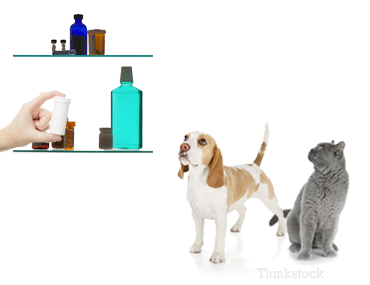
For more from Dr. Justine Lee, find her at www.drjustinelee.com or on Facebook!
Have a headache?
Before you reach for Tylenol, make sure that you keep that bottle out of reach of your dog or cat! Tylenol contains the active ingredient acetaminophen (often called paracetamol in other countries), and is a popular over-the-counter (OTC) pain medication and anti-fever medication used by humans. While this drug is very safe for human use, it has a narrow margin of safety in dogs and cats.
Unfortunately, when dogs and cats ingest acetaminophen – either accidentally or because their pet owner inadvertently gave it to them, they can develop poisoning at low doses. The severity of acetaminophen poisoning depends on the species, as dogs and cats develop different clinical signs and problems with poisoning.
Because cats have altered liver metabolism (called glucuronidation), they metabolize acetaminophen poorly, making them much more susceptible to poisoning. The toxic dose of acetaminophen in cats is very low, seen at as little as 10 mg/kg. This means that as little as one Tylenol tablet could kill a cat.
In cats, acetaminophen poisoning affects the red blood cells (RBC). Cats develop methemoglobinemia (metHb), which means that their red blood cells can’t carry oxygen. As a result, clinical signs of poisoning in cats include:
- Lethargy
- Inappetance
- Swelling of the face or paws
- Difficulty breathing
- An increased respiratory rate

- Open mouth breathing
- Vomiting
- Anemia
- Abnormal colored gums (from blue to brown instead of pink)
- Liver failure (less common)
- Death
In dogs, the toxic dose of acetaminophen poisoning is seen > 100 mg/kg. Dogs typically develop liver failure from acetaminophen, and with massive ingestions, methemoglobinemia (abnormal hemoglobin that can’t carry oxygen in the body) can also be seen. Clinical signs of acetaminophen poisoning in dogs include:
- Dry eye (chronic squinting and abnormal green discharge of the eyes)
- Inappetance
- Lethargy
- Vomiting
- Black-tarry stool
- Jaundiced gums
- Increased liver enzymes
- Walking drunk
- Coma
- Seizures
If your dog or cat gets into acetaminophen, it’s typically too late to induce vomiting, as the drug is rapidly absorbed from the stomach. Instead, treatment includes the following at your veterinary clinic:
- Activated charcoal to bind up the poison from the stomach and intestines
- Blood work to evaluate the RBC count, to look for the presence of methemoglobinemia, and to monitor the liver values
- IV fluids
- Liver protectants (such as SAMe, n-acetylcysteine)
- Oxygen therapy, if needed
- Blood transfusions, if needed
- Monitoring of oxygen levels and blood pressure
- Symptomatic supportive care
Thankfully, with acetaminophen poisoning, there’s an antidote called n-acetylcysteine (often abbreviated as NAC). Not all veterinarians carry this antidote, so if your pet got into a toxic amount of acetaminophen, referral to an emergency hospital or specialty clinic may be necessary.
The prognosis for acetaminophen poisoning is typically fair to good with supportive care and the use of the antidote. When in doubt, if you suspect your dog or cat got into acetaminophen, contact your veterinarian or emergency veterinarian right away and seek immediate veterinary attention (yes, even in the middle of the night). With any poisoning, the sooner you seek attention, the better the prognosis and the less costly or damaging to you and your pet.
If you have any questions or concerns, you should always visit or call your veterinarian – they are your best resource to ensure the health and well-being of your pets.
